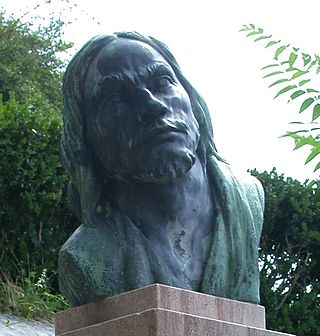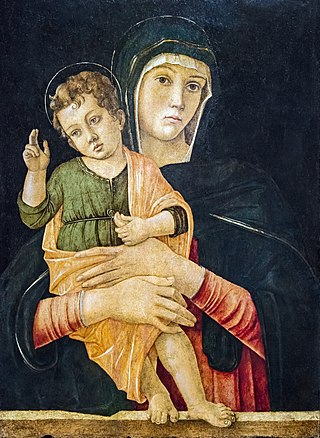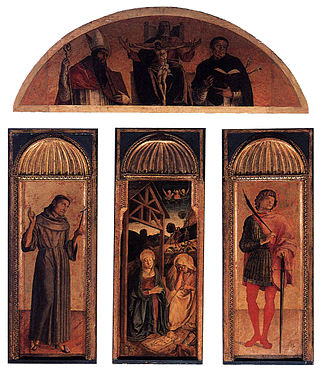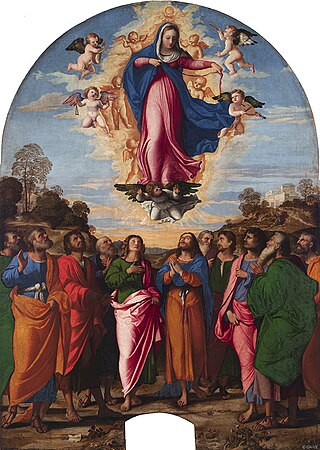
Jacopo Bellini was one of the founders of the Renaissance style of painting in Venice and northern Italy. His sons Gentile and Giovanni Bellini, and his son-in-law Andrea Mantegna, were also famous painters.

Alessandro Bonvicino, more commonly known as Moretto, or in Italian Il Moretto da Brescia, was an Italian Renaissance painter from Brescia, where he also mostly worked. His dated works span the period from 1524 to 1554, but he was already described as a master in 1516. He was mainly a painter of altarpieces that tend towards sedateness, mostly for churches in and around Brescia, but also in Bergamo, Milan, Verona, and Asola; many remain in the churches they were painted for. The majority of these are on canvas, but a considerable number, including some large pieces, are created on wood panels. There are only a few surviving drawings from the artist.

The Gallerie dell'Accademia is a museum gallery of pre-19th-century art in Venice, northern Italy. It is housed in the Scuola della Carità on the south bank of the Grand Canal, within the sestiere of Dorsoduro. It was originally the gallery of the Accademia di Belle Arti di Venezia, the art academy of Venice, from which it became independent in 1879, and for which the Ponte dell'Accademia and the Accademia boat landing station for the vaporetto water bus are named. The two institutions remained in the same building until 2004, when the art school moved to the Ospedale degli Incurabili.

Giovanni Battista Cima, also called Cima da Conegliano, was an Italian Renaissance painter, who mostly worked in Venice. He can be considered part of the Venetian school, though he was also influenced by Antonello da Messina, in the emphasis he gives to landscape backgrounds and the tranquil atmosphere of his works.

Pordenone, Il Pordenone in Italian, is the byname of Giovanni Antonio de’ Sacchis, an Italian Mannerist painter, loosely of the Venetian school. Vasari, his main biographer, wrongly identifies him as Giovanni Antonio Licinio. He painted in several cities in northern Italy "with speed, vigor, and deliberate coarseness of expression and execution—intended to shock".
The decade of the 1460s in art involved some significant events.

The Madonna dell'Orto is a church in Venice, Italy, in the sestiere of Cannaregio. This was the home parish of Tintoretto and holds a number of his works as well as his tomb.
Giovanni d'Alemagna was a Venetian renaissance painter of German ancestry, active in Italy, with his brother-in-law Antonio Vivarini on religious paintings in Venice and Padua, that are preserved in the named cities together with those of Vivarini.

The San Giobbe Altarpiece is a c. 1487 altarpiece in oils on panel by the Venetian Renaissance painter Giovanni Bellini. Inspired by a plague outbreak in 1485, this sacra conversazione painting is unique in that it was designed in situ with the surrounding architecture of the church, and was one of the largest sacra conversazione paintings at the time. Although it was originally located in the Church of San Giobbe, Venice, it is now in the Gallerie dell'Accademia in Venice after having been stolen by Napoleon Bonaparte.
Gianetto Cordegliaghi or Gianetto Cordella Aghi, also called il Cordella, was an Italian painter, active mainly in Venice.

Andrea da Murano, also known as Andrea di Giovanni was an Italian painter, active mainly in Venice and the Venetian mainland.

Madonna and Child Blessing is a 79 cm by 63 cm tempera-on-panel painting by the Italian Renaissance artist Giovanni Bellini. It dates to 1460–1464 and originally hung in the offices of the Magistrato del Monte Nuovissimo at Palazzo dei Camerlinghi in Venice, whereas it is now part of the collection of the same city's Gallerie dell'Accademia

The Barbarigo Altarpiece or Enthroned Madonna and Child with Angel Musicians and Saint Mark, Saint Augustine and Doge Agostino Barbarigo is a 1488 oil painting on panel by Giovanni Bellini, now in the church of San Pietro Martire in Murano.

The Annunciation is a c. 1500 oil-on-canvas diptych by the Italian Renaissance master Giovanni Bellini and his studio assistants. Each of the two canvases measures 224 by 105 cm and they are both now in the Gallerie dell'Accademia in Venice. They were produced as external door covers for an organ at Santa Maria dei Miracoli, Venice – on their reverses were St Peter and St Paul (lost).

The San Sebastiano Triptych is a 1464–1470 tempera-on-panel altarpiece by the Italian Renaissance artist Giovanni Bellini and others. Its central panel of saint Sebastian measures 127 by 48 cm, its lunette of God the Father and the Annunciation 59 by 170 cm and its side panels of John the Baptist and Antony the Great 103 by 45 cm. It is now in the Gallerie dell'Accademia in Venice.

The Nativity Triptych is a 1464–1470 tempera-on-panel altarpiece by the Italian Renaissance painter Giovanni Bellini and others, now in the Gallerie dell'Accademia in Venice. Its central panel of the Nativity measures 127 by 48 cm, its lunette of the Holy Trinity flanked by Augustine and Dominic 59 by 170 cm and its side panels of Francis of Assisi and Victor 103 by 45 cm.

The Triptych of the Madonna is a 1464–1470 tempera-on-panel altarpiece by the Italian Renaissance artist Giovanni Bellini and others. Its central panel of a standing Madonna and Child measures 127 by 48 cm, its lunette of the Man of Sorrows flanked by angels 59 by 170 cm and its side panels of Jerome and Louis of Toulouse 103 by 45 cm. It is now in the Gallerie dell'Accademia in Venice.

Madonna and Child Enthroned with Saints is a 1496-1498 oil painting by Cima da Conegliano, originally painted on panel but later transferred to canvas. It is also known as the Dragan Altarpiece after Giorgio Dragan, a shipowner who commissioned it for his personal altar in the church of Santa Maria della Carità in Venice. To the left of the throne is a female saint, George and Nicholas, whilst to the right are Anthony Abbot, Sebastian and another female saint.

The Assumption of the Virgin is an oil on panel painting by Palma Vecchio, created c. 1513, now in the Gallerie dell'Accademia in Venice.
















